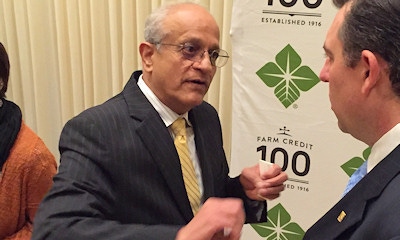March 16, 2016

It's not every day that a government official tells a group that an industry is facing an existential threat, a concern about that industry's very existence. Yet that's what Sonny Ramaswamy, head of the National Institute of Food and Agriculture said just that during a National Ag Day briefing at the National Press Club.
"When I give speeches I talk about the 9 billion people by 2020, and climate change and issues about land and water and blah, blah blah," Ramaswamy says. "These problems are happening right not and the reason I say sow is that tonight, globally 850 million people will go to bed hungry, and because of that literally a few hundred thousand will die because of that hunger."

Sonny Ramaswamy, head of the National Institute of Food and Agriculture, shares the concern that agriculture faces questions to its existence, and yet retains promise for the future.
Meanwhile, he notes 1.3 billion people will go to bed tonight after taking Lipitor, a baby aspirin, hypertension medication, medication for type 2 diabetes because of an excess amount of calories, and this is a global issue he adds.
Ramaswamy explains that agriculture faces a crisis that requires technology and research to solve. "This is an existential threat. In the late 1800s, we lived a little longer than the preceding generation, and men and women now live to be 80," he observes. "This is changing in the first decade of this century in part because of calories - children 12, and 13 years old are on hypertension medication, have type 2 diabetes."
Related: NIFA grants will support efforts to improve food security
He notes that when you combine that with the "perfect storm we've got that includes everything from diminishing land and water resources, increasing populations competing for land and water, it becomes a challenge," Ramaswamy says. And he offers a solid example of how the conversation about agriculture has changed.
When dealing with water questions there are the three F's regarding priorities for water use policy makers now take. First it's to flush, to manage waste; second it water to fish, for Engangered Species Act purposes; and the third is for farming.
"At the end of the day, food needs to be No. 1, and everything should follow around that," he notes. "We have a situation where we have diminished land resources and changing income and diets, china and India want more animal protein…there are 300 million middle class in China with the purchasing power of Americans."
Ramaswamy points to other issues that are challenging our very ability to produce food, caused by either the changing environment or politics. "But I don't want to leave you in a terrible situation, there is a path forward, which includes …innovations and discoveries we need," he says.
Gene editing and tech potential, development
Ramaswamy points to genome editing, which will allow for precise changings in the genetic make-up of plants and animals, but is not considered genetic modification. He gives the example of work at the University of Missouri where genome editing has created cattle immune from a respiratory virus. And there is more coming.
He offers another example, where photosynthesis can be managed and enhanced with genome editing. Corn is a C4 for photosynthesis and rice is a C3, which means for the same inputs - sun, water, nitrogen - corn will have twice the production of rice. "Through some genome editing we can incorporate that rate of photosynthesis into rice, allowing less use of nitrogen for raising rice around the world," he notes. "Nitrogen is reactive in the environment and is part of the creation of ozone." And he's talking about atmospheric ozone, which is a health concern for children and seniors.
Related: More support for beginning farmers
There is one problem. The technology is getting ahead of the regulators however, noting that edited-gene technologies can't be traced like biotech can since it leaves no markers in the gene (current biotech tools use marker genes). "Science is ahead of the regulations here, we need to pick up and come together with the science itself," he explains.
But while he says agriculture faces an existential threat, he isn't losing any sleep over it. "Americans have demonstrably shown they can overcome these threats and produce healthy, nutrious and healthy foods," he says. "The outcome of the work where we've invested is that we'll [beat] this existential threat."
About the Author(s)
You May Also Like






